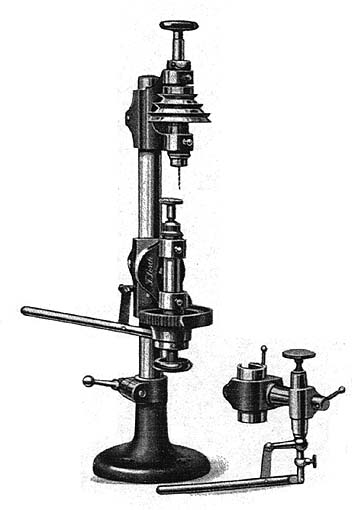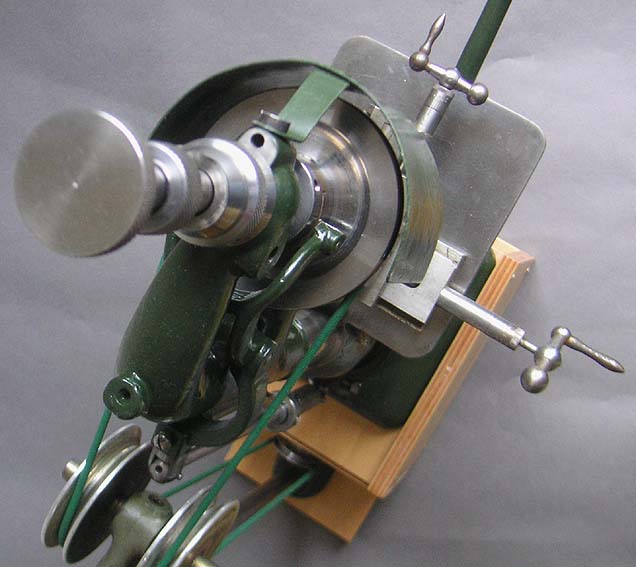last revised 22/06/24
Horological drilling machines
Drilling small (down to 0.1 mm !) holes
truly perpendicular into a work piece was made possible by a
variety of drilling machines. D-bed lathes could be clamped
vertically to the worktable and used in this position for
drilling together with a small lever-operated table that fit
into the tailstock. The next step up is to mount a lathe
headstock onto a column that is permanently fixed onto a heavy
pedestal and is again provided with a lifting drilling pad
(Figure 1). Alternatively, the drilling spindle may slide up and
down in its bearings (Figures 2, 3 and 4). A lever provided for
sensitive operation. Larger machines had sliding headstocks,
based on the lathe design, like the milling machines (Figure 5).
The drills are held in collets. The larger machines are bored
for 6 mm or 8 mm collets, the former seems to have been more
common. Later horological drilling machines are desined more
like today's pillar drills (Figure 6).
There are two machines in my collection
currently. Both bear no manufacturer's name. The smaller, and
probably older, one could have been made by Boley, judging from
the style of the machines in their catalogues (Figure 2 and 3).
It takes tiny 4 mm collets. If have set it up on a base with a
shop-made idler pulley and a little antique 220 V AC electric
motor that I had picked up on the ever obliging Viennese
flea-market.
|

|

|

|

|

|

|
|
(1)
Lorch, Schmidt Co. No. 1
drilling machine based on components from their
D-bed lathes. From a 1930s catalogue.
|
(2)
A Boley No. 76b drilling machine
from a c. 1910 catalogue.
|
(3)
Small (Boley ?) drilling
machine after restoration and set-up.
|
(4)
The small drilling machine as
received together with its wooden storage box.
|
(5)
A Boley No. 78 drilling machine from
a c. 1910 catalogue.
|
(6)
The Boley BE2 drilling machine from
a 1950s catalogue now has an electric motor
fitted.
|
The bigger drilling machine below may have
been made by Hauser. I have seen an almost identical one mounted
on a heavy base for carrying the motor that had 'HAUSER' cast
onto it. It is bored for the standard 6 mm collets. In order to
make it operational, I mounted it on a wooden base that houses a
90 W sewing-machine motor. A dimmer allows to adjust the speed.
The machine was basically complete when
received, with the exception of a ruler that indicates the
boring depth. This ruler is screwed into a hole in front of the
spindle and the micrometer drum, which serves as a depth-stop,
runs up and down along it. The same arrangement can be seen on
the miller from the Musée International d'Horologerie, La
Chaux-de-Fonds. In fact, this arrangement seems to have been
frequent on Swiss precision toolroom machines and measuring
equipment.
Though is was originally painted in the
usual machine gray, I re-painted it in a 'bottle' green to match
my other other machines. Apart from providing an aesthetically
pleasing contrast to the steel and brass/bronce parts, it is
easy on the eyes (which is why desk-tops traditionally have a
green leather surface).
Jig-boring capability is achieved by adding
a small (shop-made?) cross-slide that I happen to obtain with
some other lathe stuff. This comes very handy for drilling equal
spaced holes etc. An integrated small vice to hold small and
flat parts still needs to be made.
|

|

|

|

|
|
Hauser(?) precision drilling machine
|
Contact:
webmaster at wefalck
dot eu